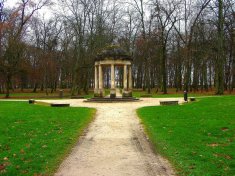My new city was a delight from the beginning. When choosing a place to live, I decided that the center of town was full of charm and history. Thus, it was only natural that my final choice for a Dijonnais domicile was a 1636 AD house on a quiet ”petite rue” in the heart of the city. The gated entrance hid a fastidious story to be written while passing through the courtyard and a 15th century solemn staircase leading to the third floor with a good view of the toits bourguignons (Burgundy’s traditional polychrome roofs) and their geometrical patterns. Yes, very quickly Dijon had my heart.
The city center is lively with a brand new TRAM system, excellent shopping and restaurants spread throughout its radius. Yet in Dijon, there is always something new to be discover. There are days dedicated to music and so you can hear great sounds in the streets or view an opera performance at the superb Auditorium of Dijon. You can take different “discovery” walks by following the owl triangles around the city and maps can be found in the tourist centers. The owl is the bird symbolizing Dijon.
The traditional story of the ‘little owl” in Dijon dates back to 14 century. It was the time when the Notre Dame cathedral was being built. One of the traditional tales conveys the story of the architect of the cathedral who found a sickly owl nearby. He cared for the tiny creature and became quite attached to the little bird. Hence, since it brought him much joy, he carved the owl on the stone pillar in north side of the cathedral. Historically, it seems that the little owl appeared in the end of the XV or beginning of the XVI centuries. Whatever the case may be, visitors continue throughout the ages to touch the little carved owl, “la petite chouette,” with the left hand while making a wish and it should come true! At Notre Dame, you will also hear the “Jacquemart” ring and announce the hours with precision. The “Jacquemart & Clock” was a war prize that Phillip the Bold brought from Belgium. Soon the inhabitants of Dijon became devoted to the protector of the hours. Accordingly, from 1651 to 1884 the people in Dijon did not wanted him to feel lonely and they added a wife Jacqueline who helps him ring the hours, a son and Jacquelinet responsible for sounding the half hours and lastly a daughter Jacquelinette responsible for ringing every quarter hour. Also, behind Notre Dame are some of the oldest streets in town known for their fine antique stores. The main cathedral in Dijon is Saint-Bénigne. It is perhaps the oldest in Dijon considering that it has a remarkable crypt which was completed in 535 AD. The grand cathedral part however, was dedicated in 1393 AD. This is one of the sites that should be visited since marvelous pipe organ concerts are frequently offered and the acoustics always make the experience sublime.
Following the little owls triangles, visitors can easily make their way to the Palace of the Dukes of Burgundy. The ducal palace houses the mayor and some of the city’s offices, a tourist information center, the soaring Philip le Bon tower in the middle and the Musée des Beaux-Arts de Dijon. After climbing the 315 steps or so in the Philip Le Bon tower, your reward will be an amazing 360° view of the city. Then, after this marvelous work-out the Musée des Beaux-Arts should be the next-door charm. In the past 2 years, this museum underwent a detailed renovation and now it is even more appealing. Worth viewing are the intricate tombs of Philip le Bon, John the Fearless and Margaret of Bavaria and the “pleurants” or mourners. Not far from this museum is one of my favorite museums in Dijon, the Museum Magnin with collections from the North, French and Italian Schools. Proximate to Magnin, the extraordinary sculptures of F. Rude can be seen at Saint-Étienne’s Church.
An international recognition for the city of Dijon is its: MUSTARD. This delicious creation dates back to 1856 AD when Jean Naigeon added acidic juice of grapes that were not ripped to the mustard recipe. This flavorful mustard is used in salads, sandwiches and on any dish that calls for mustard. Nowadays, they add white wine to the recipe with a sharp taste that revives any bland fare. Dijon also offers delightful places and parks for strolling such as the Jardin Botanique de l’Arquebuse and the Parc de la Columbière. Above all, children love Columbière Park because it has a petting zoo.



























